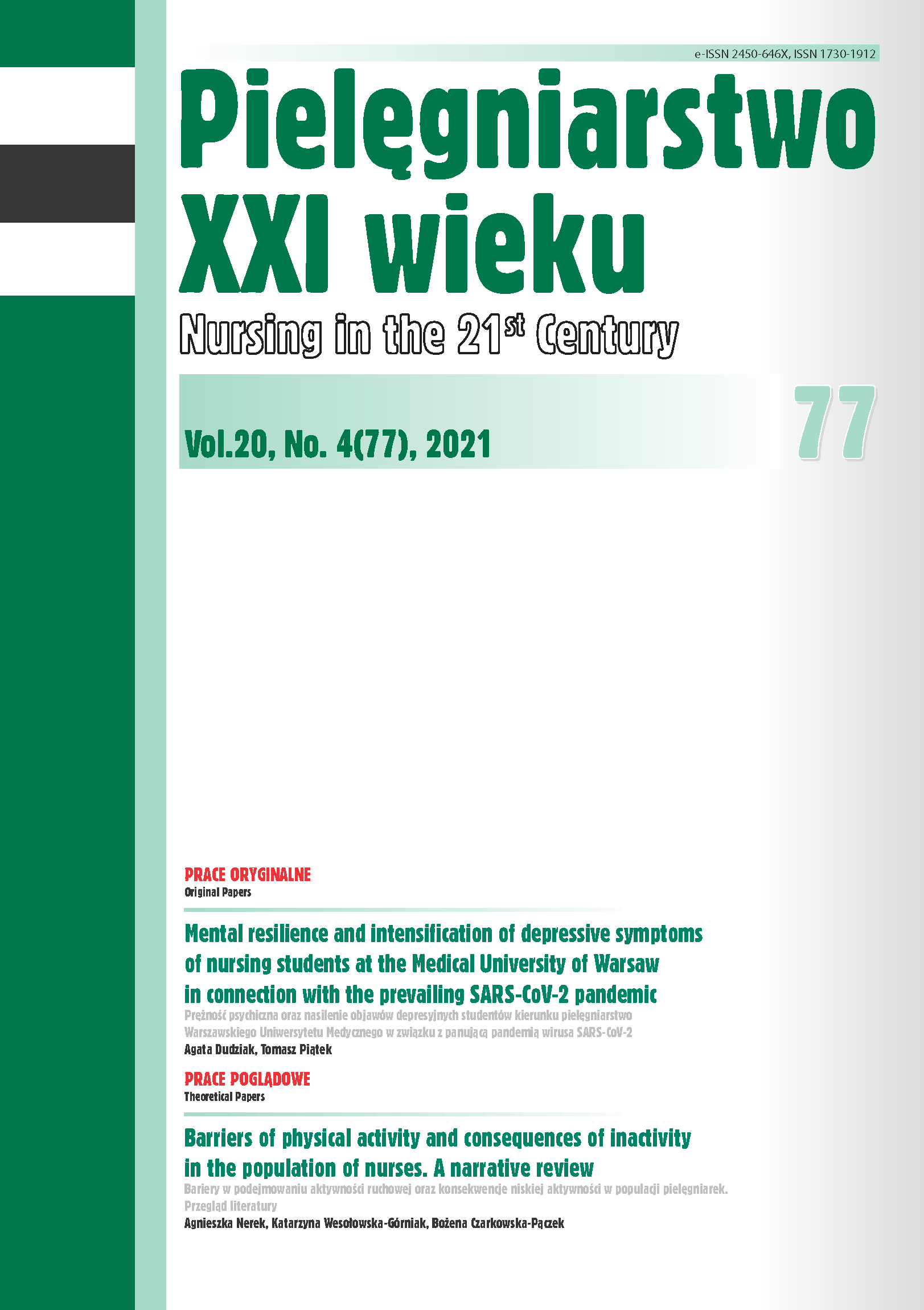Methods for the effective symptom assessment to detect delirium by nursing staff and paramedics, regardless where health services are provided
DOI:
https://doi.org/10.2478/pielxxiw-2021-0032Keywords:
delirium, nursing, emergency medical services, symptom assessmentAbstract
METHODS FOR THE EFFECTIVE SYMPTOM ASSESSMENT TO DETECT DELIRIUM BY NURSING STAFF AND PARAMEDICS, REGARDLESS WHERE HEALTH SERVICES ARE PROVIDED
Introduction. Delirium is one of the qualitative disorders of consciousness, characterized by, inter alia, changeable course, inability to focus or disorganized thinking. It can occur among patients from various age groups. The risk factors for delirium include: age over 60 years, polypharmacy, sleep disorders, simultaneous presence of dementia, pain syndromes or dehydration. There are various types of delirium (depending on the level of activity), as well as various forms (including Delirium Tremens, Excited Delirium Syndrome).
Aim. The objective of this publication is to systematize knowledge about delirium and providing appropriate tools for assessing the occurrence of delirium in different patients, so as to simplify a quick and efficient detection of the disorder by medical personnel.
Conclusions. This publication describes tools that can be used in pre-hospital and in-hospital practice, including departments caring for critically ill patients, requiring, for example, mechanical ventilation (intensive care units, cardiac intensive care units, intensive toxicological supervision units, etc.). In addition, practical aspects have been taken into account, and solutions taken from other publications that can be implemented in daily work with the patient have been proposed – a combination of several tools for quick, easy and reliable detection of delirium in the subject.
References
1. Jarema M. Psychiatria. Warszawa: PZWL Wydawnictwo Lekarskie, Wyd. II. 2016; s. 71, 228-229, 322.
2. Patti L, Gupta M. Change In Mental Status. 2020 Aug 10. In: StatPearls [Internet]. Treasure Island (FL): StatPearls Publishing; 2020 Jan. PMID: 28723002. https:// pubmed.ncbi.nlm.nih.gov/28723002/ (15.01.2021)
3. Jaeschke R, Brudkiewicz P. Majaczenie (delirium). Medycyna Praktyczna. Kraków; 2015. https://www.mp.pl/pacjent/objawy/122089,majaczenie-delirium (15.01.2021)
4. Pietraszek P. Delirium w oddziale intensywnej terapii. Anestezjologia i Ratownictwo. 2011; 5: 414-423.
5. Holt R, Teale EA, Mulley GP, et al. J. A prospective observational study to investigate the association between abnormal hand movements and delirium in hospitalised older people. Age and Ageing. 2015; 44(1): 42-45.
6. Kotfis K, Biernawska J, Zegan-Barańska M, i wsp. Metoda oceny splątania na oddziale intensywnej terapii (CAM-ICU) – Pełny podręcznik szkoleniowy. 2014 http://www.proicu.pl/images/pdf/CAM-ICU_Training_Manual_Polish_Nov2015. pdf (15.01.2021).
7. Klich-Rączka A, Piotrowicz K. Frequency of occurrence, death rate and risk factors of delirium among a group of ≥ 80-year-olds hospitalized in the department of internal medicine – a pilot study. Gerontologia Polska. 2009; 17(1): 32-38.
8. Otremba J. Risk factors for delirium in patients referred to the Geriatric Ward in nurses’ perspective. Farmacja Współczesna. 2012; 5: 99-105.
9. Michniewicz M, Wilimski R, Henzel P. Diagnosis, prevention and treatment of delirium after cardiac surgery – own experience. Folia Cardiologica. 2017; 12(3): 328-332.
10. Grover S, Ghosh A. Delirium Tremens: Assessment and Management. J. Clin. Exp. Hepatol. 2018; 8(4): 460-470.
11. Schuckit MA. Recognition and Management of Withdrawal Delirium (Delirium Tremens). N. Engl. J. Med. 2014; 371: 2109-2113.
12. Salottolo K, McGuire E, Mains CW, et al. Occurrence, Predictors, and Prognosis of Alcohol Withdrawal Syndrome and Delirium Tremens Following Traumatic Injury. Crit. Care Med. 2017; 45(5): 867-874.
13. Takeuchi A, Ahern TL, Henderson SO. Excited delirium. West J. Emerg. Med. 2011; 12(1): 77-83.
14. Vilke GM, DeBard ML, Chan TC, et al. Excited Delirium Syndrome (ExDS): defining based on a review of the literature. J. Emerg. Med. 2012; 43(5): 897-905.
15. Międzynarodowa Klasyfikacja Chorób i Problemów Zdrowotnych (International Classification of Diseases – ICD-10) https://www.icd10.pl/ (15.01.2021).
16. Jones RN, Cizginer S, Pavlech L, et al. Assessment of Instruments for Measurement of Delirium Severity: A Systematic Review. JAMA Intern. Med. 2019; 179(2): 231-239.
17. Wong CL, Holroyd-Leduc J, Simel DL, et al. Does This Patient Have Delirium? Value of Bedside Instruments. JAMA. 2010; 304(7): 779-786.
18. Rasheed AM, Amirah MF, Abdallah M, et al. Ramsay Sedation Scale and Richmond Agitation Sedation Scale. Dimensions of Critical Care Nursing. 2019; 38(2): 90-95.
19. Gaudreau JD, Gagnon P, Harel F, et al. Fast, systematic, and continuous delirium assessment in hospitalized patients. J. Pain Symptom Manage. 2005; 29(4): 368-375.
20. Kotfis K, Zegan-Barańska M, Żukowski M, et al. Multicenter assessment of sedation and delirium practices in the intensive care units in Poland - is this common practice in Eastern Europe?. BMC Anesthesiol. 2017; 17(1): 120.
21. Detroyer E, Timmermans A, Segers D, et al. Psychometric properties of the intensive care delirium screening checklist when used by bedside nurses in clinical practice: a prospective descriptive study. BMC Nursing. 2020; 19(1).
22. Han JH, Wilson A, Vasilevskis EE, et al. Diagnosing delirium in older emergency department patients: validity and reliability of the delirium triage screen and the brief confusion assessment method. Ann. Emerg. Med. 2013; 62(5): 457-465.
23. Instructions on using the Delirium Triage Screen https://uploads-ssl.webflow. com/5b0849daec50243a0a1e5e0c/5bb37816b850acb49b7c60c8_dts_flowsheet. pdf (15.01.2021).
Downloads
Published
Issue
Section
License
Copyright (c) 2021 Authors

This work is licensed under a Creative Commons Attribution-NonCommercial-NoDerivatives 4.0 International License.




